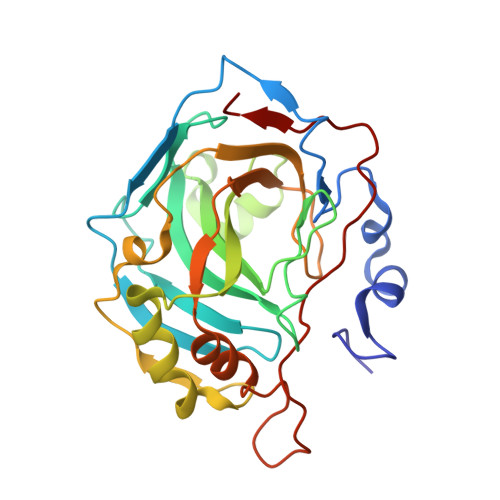Inclusion of a 5-fluorouracil moiety in nitrogenous bases derivatives as human carbonic anhydrase IX and XII inhibitors produced a targeted action against MDA-MB-231 and T47D breast cancer cells.
Petreni, A., Bonardi, A., Lomelino, C., Osman, S.M., ALOthman, Z.A., Eldehna, W.M., El-Haggar, R., McKenna, R., Nocentini, A., Supuran, C.T.(2020) Eur J Med Chem 190: 112112-112112
- PubMed: 32044580
- DOI: https://doi.org/10.1016/j.ejmech.2020.112112
- Primary Citation of Related Structures:
6VJ3 - PubMed Abstract:
A new series of pyrimidine derivatives as human carbonic anhydrases (CA, EC 4.2.1.1) inhibitors is here designed by including a 5-fluorouracil (5-FU) moiety, broadly used anticancer medication, in nitrogenous base modulators of the tumor-associated CAs. Most sulfonamide derivatives efficiently inhibit the target CA IX (K I s in the range 0.47-44.7 nM) and CA XII (K I s in the range 2.9-83.1 nM), while the 5-FU coumarin derivatives showed a potent and totally selective inhibitory action against the target CA IX/XII over off-target CA I/II. The X-ray solved crystal structure of CA II in adduct with a representative uracil derivative provided insights on the binding mode to the target of such pyrimidine derivatives. On the basis of potency and selectivity inhibition profiles, coumarin 12a, the sulfonamide CAIs showing the greatest II/IX specificity (4e, 6b and 6d) and the unique subnanomolar CA IX inhibitor 10a were tested in vitro for their antiproliferative action against a panel of eight cancer cell lines. The breast cancer cell lines MDA-MB-231 and T47D were the most susceptible with IC 50 values in low to medium micromolar ranges (2.45 ± 0.07-18.86 ± 0.72 μM and 6.86 ± 0.31-40.92 ± 1.59 μM, respectively). A cell cycle analysis showed that 4e and 6d arrest T-47D cells mainly in the G2/M phase. Using an annexin V-FITC apoptosis assay, 4e and 6d were shown to induce an approximately 23.6-fold and 34.8-fold total increase in apoptosis compared to the control, corroborating the concrete potential of 5-FU CAIs for the design of new effective anticancer strategies.
Organizational Affiliation:
University of Florence, Department of NEUROFARBA, Section of Pharmaceutical and Nutraceutical Sciences, via Ugo Schiff 6, 50019, Sesto Fiorentino, Florence, Italy.
















